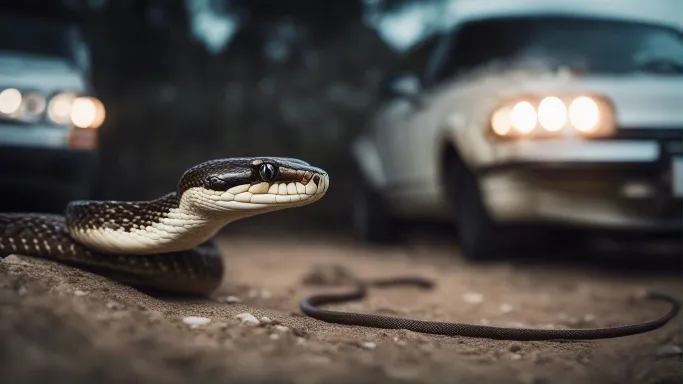Imagine driving down a scenic country road, windows down, enjoying the fresh air, when suddenly a shiver runs down your spine.
The horrifying thought crosses your mind: can a snake get in your car? As it turns out, the answer is not as black and white as you might think.
In this article, we will explore whether or not these slithery creatures can invade your vehicle sanctuary, and what you can do to prevent a terrifying surprise on your next excursion.
Buckle up and prepare to uncover the truth about snakes and cars.

Understanding snake behavior
Snakes are fascinating creatures with unique behaviors. Before delving into the question of whether snakes can get into cars, it’s helpful to understand their natural tendencies.
Snakes are highly adaptable and can reside in a wide range of environments, from dense forests to open grasslands.
They are excellent climbers and can maneuver through various obstacles with incredible speed and agility.
Additionally, snakes have a remarkable ability to squeeze through small openings due to their flexible bodies.
Types of snakes that may enter cars
While most snakes prefer to avoid human contact and are unlikely to seek shelter inside cars, certain species are more prone to enter vehicles.
These include snakes that are attracted to warm environments, such as garages or engine compartments, and those that use cars as a source of food or shelter.
Common snake species that may enter cars include rat snakes, black racers, garter snakes, and sometimes even venomous snakes like rattlesnakes or copperheads.
Reasons why snakes may enter cars
Snakes, like any living creature, have specific reasons for seeking shelter or exploring their surroundings.
When it comes to cars, there are several factors that can attract snakes. One primary reason is seeking warmth.
Cars, especially during colder months or in regions with cooler climates, can provide a cozy and inviting environment for snakes.
Additionally, snakes may enter cars in search of prey, such as mice or rats that have made their home inside the vehicle.
Preventing snakes from entering your car
While it may be unsettling to think of a snake slithering into your car, there are steps you can take to minimize the likelihood of such an occurrence.
First and foremost, proactive measures to discourage snakes from approaching your vehicle can make a significant difference.
These may include keeping the area around your car free from tall grass or debris, as these can attract snakes and provide hiding spots.
Regularly inspecting and servicing your car’s engine compartment can also help identify potential entry points and prevent snakes from making their way inside.
Checking for snakes in your car
If you reside in an area where snake encounters are relatively common, it’s a good idea to conduct regular checks for snakes in and around your car.
Before entering your vehicle, take a quick glance under the seats and in the trunk to ensure no snakes have sought refuge there.
It’s also advisable to inspect the exterior of your car for any signs of snake activity, such as shed skin or snake droppings. By being vigilant, you can reduce the chances of an unexpected snake encounter.
What to do if you find a snake in your car
If you happen to discover a snake in your car, it’s important to remain calm and take appropriate action.
Firstly, do not attempt to handle the snake yourself unless you have experience and knowledge of how to do so safely.
Trying to remove or capture a snake without the necessary expertise can lead to unnecessary harm, both to yourself and the snake.
Instead, call a professional snake removal service or animal control agency, who will have the necessary expertise and equipment to handle the situation safely.
Common myths about snakes getting in cars
Like many topics surrounding snakes, there are several myths and misconceptions about them getting into cars.
One prevalent myth is that snakes can bite through car tires or enter the vehicle through the exhaust pipe.
However, these claims are not based on scientific evidence. Snakes lack the necessary ability to penetrate rubber tires or navigate the complex structures of exhaust systems.
It’s crucial to rely on accurate information and scientific knowledge when understanding snake behavior and dispelling common myths.
Snake encounter stats and case studies
While snake encounters in cars are relatively rare, there have been documented instances of snakes finding their way into vehicles.
By analyzing these cases, we can gain valuable insights into snake behavior and understand the circumstances that may lead to such encounters.
Data from snake removal services and wildlife agencies can provide statistics on the frequency and locations of snake incidents in cars.
By studying these stats and case studies, we can better comprehend the factors that contribute to snakes entering vehicles.
Famous incidents of snakes in cars
Throughout history, there have been notable incidents involving snakes in cars that have captured public attention.
One memorable case occurred in Australia, where a venomous snake was discovered slithering around a car’s interior, surprising the driver.
Another incident involved a family in the United States who came across a non-venomous snake coiled on the backseat during a road trip.
While these incidents are relatively rare, they highlight the potential for unexpected encounters with snakes while inside a vehicle.
Final Thoughts
While it is possible for a snake to enter your car, the likelihood of such an occurrence is relatively low.
Understanding snake behavior, taking preventive measures, and conducting regular checks can further lower the risk of encountering a snake in your vehicle.
Should you find a snake in your car, it is essential to remain calm and seek professional assistance to handle the situation safely.
By debunking common myths and studying snake encounter statistics, we can gain a better understanding of these intriguing creatures and coexist with them peacefully.



